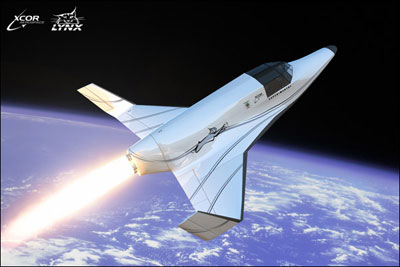Notes on the state of the RLV industry in 2008 (part 2)by Taylor Dinerman
|
| Mojave may become the center of the RLV industry the same way that San Jose and the surrounding area—Silicon Valley—became the center of the computer industry. |
The idea is, that by following a one-step-at-a-time process—also called crawl-walk-run—a developer can move from a subscale prototype to a full-scale test model and then to an operational suborbital vehicle. After this has proven itself, a series of ever-better vehicles can then be built based on proven technology until, eventually, one achieves orbital velocity. It was—and is—a logical plan, but whether it can be made to work profitably is still a question.
There still are more than a few of these firms out there, but there are two from that era that have managed to make it with little support from mega-angel investors or big defense contractors. Two of these are XCOR Aerospace of Mojave, California, and TGV Rockets of Norman, Oklahoma.
Mojave may become the center of the RLV industry the same way that San Jose and the surrounding area—Silicon Valley—became the center of the computer industry. There are at least two visionary companies based there, the area has room to grow, and, most importantly, there is a community of people who are passionately interested in the technology and its potential. Lessons and some ideas are shared in spite of the legitimate efforts of all involved to keep their business secrets, well, secret. As George Gilder put it when he was writing about the emergence of the semiconductor industry, “Among media pundits these people often fail to pass social muster. In 1987, for example, a visitor from the New York Times discovered the [Silicon] Valley to be full of unsophisticated rubes and obsessives.” The RLV industry is similarly rich with such hard driving creativity.
XCOR may still be scrambling to survive but they are still building rockets and winning contracts. They managed, with their partner ATK, to build a testbed engine that runs on liquid oxygen and methane. This engine is a small but important step towards a rocket engine that could be fueled with the end products of in situ resource utilization (ISRU), an essential part of future human exploration of the solar system.
Closer to Earth they have built the first rocket plane for the Rocket Racing League (RRL). This is, in itself, quite an achievement. They had already built a smaller rocket plane based on one of Burt Rutan’s Long-EZ planes. Now they have built a more advanced craft and have been flying the prototype X Racer since October 2007. It weighs about 1,400 kilograms at take off and has a maximum speed of 370 kilometers per hour: a long, long way from orbital velocity, but a good way to build their in-house expertise. One hopes that as the Rocket Racing League becomes a successful enterprise, building these craft and perhaps more powerful versions will be an enduring source of profits for XCOR.
In March of this year XCOR unveiled its entry into the suborbital tourism field, the Lynx. It is obviously a major step up in performance from the X Racer. It is planned to be a Mach 2 vehicle that can reach over 60 kilometers above the Earth. It will carry a pilot and a single passenger. It is hoped that they will be able to sell suborbital flights for $100,000, half of what Virgin Galactic plans to charge and with far less of the overall “lifestyle event” aspects of space tourism that Richard Branson’s firm is planning to offer. If and when the Lynx starts flying paying passengers they will be getting an austere and “hard” space tourism experience. The first customers who fly in this vehicle are going to feel more like pioneers than like passengers.
While TGV Rockets has not yet built a vehicle, not even a subscale version of their Michelle B Rocket design, they have tested a 135,000-newton thrust engine powered by JP-8 kerosene and liquid oxygen. According to company spokesmen the tests went smoothly. By contrast, the Rocket Racer’s engine has 6,700 newtons of thrust and the Space Shuttle’s main engines have 1.5 million newtons.
| In some ways its better for the small firms to be free to try—and sometimes fail—to build these kinds of rocket ships without the kind of close and obtrusive supervision that a larger military aerospace contractor would receive. |
This is one of the very few brand new rocket engines being developed in the US today. This makes TGV, along with SpaceX and Scaled Composites, an important part of the US space industrial base. While NASA and the Defense Department have been abandoning technologically ambitious space vehicle development, these small firms have stepped into the breach.
In some ways its better for the small firms to be free to try—and sometimes fail—to build these kinds of rocket ships without the kind of close and obtrusive supervision that a larger military aerospace contractor would receive. They are free to make mistakes and to learn from them without having the proverbial 2,000 second lieutenants with clipboards breathing down their necks. However, America needs to nurture this industry if it is to maintain its lead in space technology.
Back in the late 1970s European and Japanese observers thought that the US was losing its edge in the computer industry because they saw that IBM was faltering. Microsoft, Intel, and Cisco, among many others, either did not exist or were merely wisps of clouds on the horizon. Today, when Boeing is struggling and when the rest of the US industry is facing increasing competition and is searching high and low for the next generation of engineering and scientific talent, the small RLV industry is building a community of knowledge that may be the key to keeping the US space industry at the top of the technological food chain.
